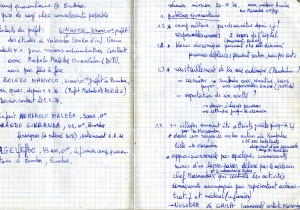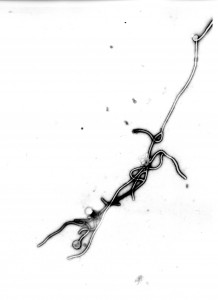The archival holdings at the London School of Hygiene & Tropical Medicine document the initial international response to the virus from 1976-1977. This chiefly takes the form of fieldwork conducted by our current Director, Professor Peter Piot, who was part of the team based at the Institute of Antwerp that first isolated the virus and who later joined the WHO International Expedition in the Yambuku district, Bamba Province to investigate and prevent the spread of the then unknown pathogen.
I wrote a post about his fieldwork last year (“Peter Piot in the Ebola Outbreak in the Yambuku, 1976“), but have recently received three additional notebooks from him written during his time in Yambuku district. These notebooks written in French and Dutch give detailed notes of his work from the 18th October to the 8th September 1976. They contain a mixture of diary entries, patient notes and extensive notes on the epidemiological surveillance investigation in the Yambuku including the initial International scouting expedition to the region where he examined some of the survivors of the epidemic. The expedition is captivatingly recalled in his memoir, No Time to Lose: A Life in Pursuit of Deadly Viruses’ with his archival papers providing illuminative evidence of both the clinical characteristics of the disease and the scale and logistics of conducting an epidemiological survey in a large remote region.
The Ebola outbreak that occurred in 1976 was one of the first epidemics to produce a rapid international response to the work. Whilst the Institute of Tropical Medicine (ITM), based in Antwerp, were the first to isolate the viral particle, other institutions were working in collaboration with them including the CDC in Atlanta, USA and Porton Down in the UK. The Ebola tissue samples from the ITM were eventually passed onto Porton Down for further analysis and whilst there D I H Simpson and Dr S Ellis, from the Department of Microbiology at LSHTM collaborated together on investigating the structure of the virus using electro-microscopy. They published their findings in the Journal of Clinical Pathology in 1978, ‘Ultrastructure of Ebola virus particles in human liver’. The archives contain an offprint of this article along with black and white prints of electro-microscopy images of the virus used in the publication and additional research on Ebola virus in monkeys and images of space-filled model of the virus.
Almost four decades on since the first epidemic of the virus was reported scientists are no closer to a cure. Whilst more is known about the virus, it still maintains its mantle as one of the world’s deadliest viruses and one that sadly could to continue to reoccur as under-funded health systems try to control a lethal epidemic.









